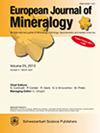Fe-Fe相互作用和x位空位排序对铁长石oh -拉伸谱的影响
IF 1.7
3区 地球科学
Q2 MINERALOGY
引用次数: 1
摘要
摘要根据含铁Y3Z6团簇在电气石中的密度泛函理论(DFT)模型,解释了电气石样品的OH拉伸红外吸收光谱。含铁团簇反映了铁铁矿的富铝和缺钠特征,在Y位含有两个Fe2+和一个Al3+或两个Al3+离子。这些团簇嵌入电气石主体结构中,具有dravite成分。对于它们的on-二聚体模型,考虑了与它们的on自旋的铁磁(FM)或反铁磁(AFM)排列相对应的结构和振动特性,以及沿[001]轴的空位有序效应。观察到FM和AFM团簇的弛豫结构存在显著差异,这源于FM团簇中的电子离域和Fe–Fe键合相互作用。这些键合相互作用在AFM簇中是不允许的。在这种情况下,具有相反自旋的价电子保持分别位于两个Fe原子上。在理论模型中,如果在DFT中改进了对Fe(3d)轨道中现场库仑排斥的描述,则AFM组态比FM组态更稳定 + U框架。根据理论结果,3630和3644两个波段 在富铁电气石和缺钠电气石的振动光谱中,cm−1被归属于WOH基团,该基团与具有Fe离子的AFM耦合的YFe22+YAl3+环境有关,并且分别被一个和两个空位X包围。实验光谱的两个主要VOH带是在相同的基础上解释的,这些解释被外推到含锰电气石。本文章由计算机程序翻译,如有差异,请以英文原文为准。
Effect of Fe–Fe interactions and X-site vacancy ordering on the OH-stretching spectrum of foitite
Abstract. The OH-stretching infrared absorption spectrum of a tourmaline sample close
to the foitite end-member is interpreted in the light of the density
functional theory (DFT) modeling of iron-bearing Y3Z6 clusters in
tourmaline. The iron-bearing clusters reflect the Al-rich and Na-deficient
character of foitite and contain either two Fe2+ and one Al3+ or
one Fe2+ and two Al3+ ions at the Y sites. The clusters are
embedded in a tourmaline host structure with dravite composition. For the
iron dimer models, the structural and vibrational properties corresponding
to the ferromagnetic (FM) or anti-ferromagnetic (AFM) arrangement of the
iron spins and the effect of vacancy ordering along the [001] axis are
considered. A significant difference in the relaxed structure of the FM and
AFM clusters is observed, stemming from the electron delocalization and
Fe–Fe bonding interactions in the FM cluster. These bonding interactions are
not allowed in the AFM cluster. In this case, the valence electrons with
opposite spins remain separately localized on the two Fe atoms. The AFM
configuration is more stable than the FM one in the theoretical models,
provided that the description of the on-site Coulomb repulsion in Fe(3d)
orbitals is improved within the DFT + U framework. Based on the theoretical
results, the two bands at 3630 and 3644 cm−1 in the vibrational spectra
of iron-rich and Na-deficient tourmalines are assigned to WOH groups
associated with YFe22+YAl3+ environments with an
AFM coupling of Fe ions and surrounded by one and two vacant X sites,
respectively. The two major VOH bands of the experimental spectrum are
interpreted on the same basis, and these interpretations are extrapolated to
Mn-bearing tourmalines.
求助全文
通过发布文献求助,成功后即可免费获取论文全文。
去求助
来源期刊
CiteScore
2.80
自引率
9.50%
发文量
40
审稿时长
6-12 weeks
期刊介绍:
EJM was founded to reach a large audience on an international scale and also for achieving closer cooperation of European countries in the publication of scientific results. The founding societies have set themselves the task of publishing a journal of the highest standard open to all scientists performing mineralogical research in the widest sense of the term, all over the world. Contributions will therefore be published primarily in English.
EJM publishes original papers, review articles and letters dealing with the mineralogical sciences s.l., primarily mineralogy, petrology, geochemistry, crystallography and ore deposits, but also biomineralogy, environmental, applied and technical mineralogy. Nevertheless, papers in any related field, including cultural heritage, will be considered.

 求助内容:
求助内容: 应助结果提醒方式:
应助结果提醒方式:


